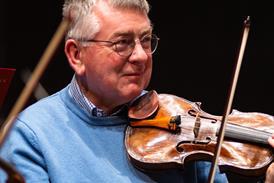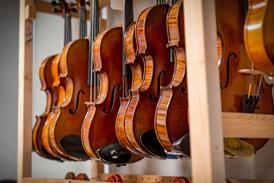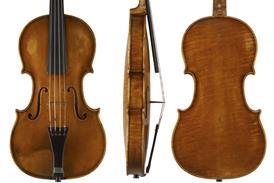Conductor Leonard Slatkin shares how he approaches working with symphonic string sections, which he describes as ‘the heart and soul of the ensemble’

Discover more Featured Stories like this in The Strad Playing Hub
They play more notes than anyone else on the stage. They appear in almost every work performed by an orchestra. They can be the heart and soul of the ensemble, differentiating orchestras from their counterparts in the band world.
The strings can be identified by their clarity, intonation, sonic brilliance, or blend. Just watching them can be an object lesson in uniformity or an exercise in frustration. The conductor relies on the principals of each section to build a cohesive unit.
How does the music director, at least in America, formulate—much less establish—that singular sonority? For me, that is truly the question of the day. To understand the answer, we must go back to a time long past. I grew up in a family of string players, surrounded in Hollywood by some of the greatest in the world. Their sound is emblazoned in my ear, and I always try to bring it with me when I conduct.
Not many musicians or even concertgoers remember the lush Philadelphia sound of Stokowski and Ormandy, the razor-sharp attacks of Szell’s Cleveland Orchestra, or the aristocratic and refined resonance of the Boston Symphony under Koussevitzky. The orchestras of those days saw their music directors conducting more than half of the concerts in a season. These maestros put their individual stamp on virtually every piece of repertoire they led, and in turn, the guests who visited their podiums accepted what they were handed.
When I made my debut with the Philadelphians, Ormandy was on hand to introduce me to his orchestra. The programme was all-orchestral, and the first half contained unfamiliar works by American composers. The second part consisted of Rachmaninoff’s Second Symphony, virtually owned by this ensemble. What could I possibly say to them in terms of how to play and sound in this piece?
The answer was: nothing. I simply let them do their thing, and they adjusted to some slightly different phrasings, dynamics, and tempi. My approach was the same for any orchestra I led that had a distinctive string personality. I was simply a guest in the house and did not want to move the furniture around.
Until the 1970s or so, music directors had almost free rein over who played in their orchestras. If there was a string vacancy, perhaps the leader of a given section would consult with the conductor as to who should enter the group. Yes, audition committees existed, but they were mostly there to rubber-stamp the wishes of the leadership.
Several factors led to the hiring decisions: the candidate’s vibrato, use of bow, instrument, and even demeanor (this was before screens blocked visual access during auditions) were all in play. Alternatively, a music director might have heard an individual in another city and simply recruited them on the spot.
The most important relationship was, and still is, between the concertmaster and the conductor. For that reason, this position was almost always the result of direct contact rather than audition. As Joey Silverstein once said, the concertmaster does not have to be liked by everyone but must be respected. Since the concertmaster only answered to the music director, players dared not speak against that person, lest they risk being terminated for insubordination.
Another key factor in establishing the sonic profile of the string section has to do with the venue where the orchestra performs. In a dry acoustic, the conductor must compensate to make the sound feel warmer when appropriate. And when the acoustic is reverberant, short notes, for example, must be even shorter than usual to be heard clearly.
The orchestras I mentioned earlier all adjusted to their halls, not the other way around. Chicago and Philadelphia played in very dry venues, but the music directors knew how to make them sound fantastic in those places. Even the positioning of the sections can make a difference.
When I was in D.C., the concert hall had significant deficiencies in terms of the musicians hearing each other properly, as well as an almost complete lack of lower-register depth. After a couple of years, I placed the violins antiphonally, moving the celli and basses to the left side, with their f-holes now facing out toward the audience. It helped, I thought, but was still less than ideal.
In Detroit—a fine hall, certainly—I felt that the violas, which were seated on the inside right, were being swamped by the instruments around them, so I flipped them with the cello section. Bringing the violas forward helped balance the alto line without sacrificing the sound of the lower voices. However, when I am a guest, I always accept the stage setup established by the orchestra’s music director.

Sadly, the increased demands of an ever-expanding repertoire, and perhaps a lack of true understanding of string sound, can diminish an ensemble’s capacity to achieve a unique sonic profile. This is where the winds have an advantage. Their personalities are on display in almost every piece, whereas the strings are almost always perceived as a homogenised entity. The musicians train for years, learning their technique and developing their individual tone quality. Then, they get into an orchestra and become part of the collective, with little or no opportunity to express themselves in the ways that they were taught.
In an age that values technical proficiency, perhaps it is time to consider some of the old ways once again. Music directors need to spend more time with their orchestras, not less. And they must really work with their section leaders to develop a unified and distinctive sound for their ensembles.
Ultimately, it begins and ends with the strings.
On 25 and 27 October, Leonard Slatkin conducts his hometown St. Louis Symphony Orchestra in a special celebration of his 80th birthday - featuring a number of works close to his heart (and family), including the world premiere of his arrangement of Scarlatti’s Five Sonatas for Orchestral Wind Ensemble, his wife Cindy McTee’s Timepiece, the US premiere of his son Daniel’s Voyager 130, and Tchaikovsky’s Symphony No. 5. Find out more here: https://shop.slso.org/8174
Photos courtesy Leonard Slatkin
Read: Beyond the Metronome - Benjamin Zander on Beethoven’s Ninth Symphony
Read: From the Archive: conducting tips for players
Discover more Featured Stories like this in The Strad Playing Hub
The number one source for playing and teaching books, guides, CDs, calendars and back issues of the magazine.
In The Best of Technique you’ll discover the top playing tips of the world’s leading string players and teachers. It’s packed full of exercises for students, plus examples from the standard repertoire to show you how to integrate the technique into your playing.
The Strad’s Masterclass series brings together the finest string players with some of the greatest string works ever written. Always one of our most popular sections, Masterclass has been an invaluable aid to aspiring soloists, chamber musicians and string teachers since the 1990s.
The Canada Council of the Arts’ Musical Instrument Bank is 40 years old in 2025. This year’s calendar celebrates some its treasures, including four instruments by Antonio Stradivari and priceless works by Montagnana, Gagliano, Pressenda and David Tecchler.






































No comments yet